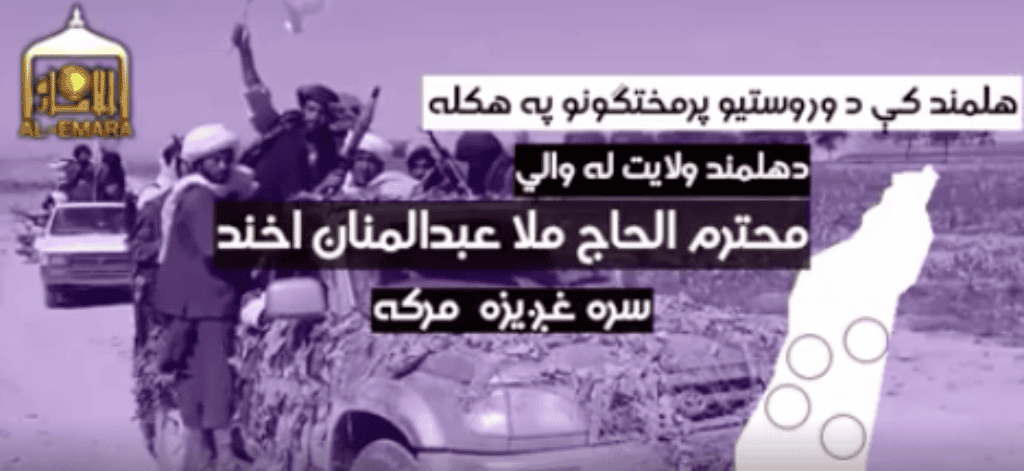
Image accompanying and audio clip from Mullah Manan, the Taliban’s shadow governor of Helmand province.
The Taliban denied reports that both its shadow governor for Helmand province and his military commander were killed in a US airstrike in the southern Afghan province of Helmand. The Afghan government has a questionable track record when reporting on the deaths of Taliban commanders.
The provincial governor’s office for Helmand announced today that “Mullah Abdul Rahim and Commander Mustaqeem,” the Taliban’s shadow governor for Helmand and his military commander, were killed in a US drone strike, Khaama Press reported. The airstrike purportedly targeted the two in the village of Zarghoon village in Nad Ali district.
The US military has not yet commented on the airstrike, but it has stepped up attacks on the Taliban leadership and other key nodes after the jihadist group has gained ground against government forces over the past year.
The Taliban, via one of its official spokesmen, Qari Yousuf Ahmadi, quickly issued a denial that its top two leaders in Helmand were killed in an airstrike. Ahmadi’s statement was published on the Twitter account of Zabihullah Muhajid, another official spokesman for the Taliban. Ahmadi denied that the two Taliban leaders were killed and called the government’s claims “false rumors” designed to detract from its military defeats in Helmand.
“We strongly reject this propaganda,” Ahmadi said in the statement.
The Taliban’s shadow governor for Helmand is Mullah Abdul Manan Akhund, not Mullah Abdul Rahim, as the Afghan government claimed. The shadow governor for Helmand was identified by the Taliban as Mullah Abdul Manan Akhund in 2015 after announcing the death of its emir, Mullah Omar, and again in 2016 after the death of Omar’s successor, Mullah Mansour. And in the statement released by Ahmadi, the shadow governor was also identified as Mullah Abdul Manan Akhund.
Additionally, Ahmadi released an audio clip purporting to be that of Helmand’s shadow governor, Mullah Manan. However it is unclear if the audio was recorded after the reports of Mullah Manan’s death.
In the audio, the Taliban claimed that the districts of Nad Ali and Nawa-i-Sarraj in Helmand are “under Mujahideen control” after heavy fighting with Taliban forces. The Taliban’s claims cannot be independently confirmed, but it has accurately reported on the control of districts in the past while the Afghan government has downplayed or ignored districts lost to the Taliban. The Taliban currently control or contest more than 80 of Afghanistan’s 400 plus districts, according to a study by The Long War Journal. That number may be higher as reports from some districts known to be Taliban strongholds are unavailable. [See LWJ report, Taliban seizes district in northern Afghanistan.]
Security in Helmand has deteriorated as the Taliban has pressed its offensive to regain the ground lost there between 2009-2011. Of Helmand’s 14 districts, five are known to be controlled by the Taliban (Now Zad, Musa Qala, Baghran, Dishu, and Khanashin), and another seven are heavily contested (Nahr-i-Sarraj, Kajaki, Nad Ali, Nawa-i-Barak, Marjah, Garmsir, and Sangin). Of the remaining two districts, The Long War Journal believes one (Washir) is contested, but the situation is unclear. Only Lashkar Gah, the district that hosts the provincial capital, has not seen significant Taliban activity, however the Taliban has reported activity there. But Taliban forces based in Nahr-i-Sarraj and Nad Ali are just miles from the city.
While it is exceedingly difficult to assess the status of Taliban commanders based on the claims of the Afghan government and the Taliban, particularly after the Taliban was exposed for hiding Mullah Omar’s death for more than two years, the Taliban maintains a better track record. The Taliban frequently rebuts government claims by releasing audio of its commanders denying their deaths.
For instance, last month, Afghanistan’s Ministry of the Interior claimed that the Taliban’s shadow governors for Ghazi and Logar province were killed in airstrikes. The Taliban quickly denied the reports. And in October 2015, the government claimed it killed the Taliban’s shadow governor for Kunduz. The Taliban responded by publishing an interview with Salam, whose forces took control of Kunduz City for two weeks in the fall of 2015.







